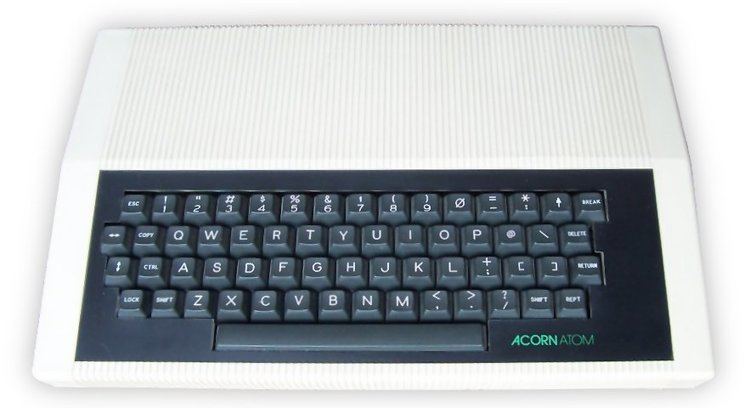Manufacturer Acorn Computers Discontinued 1983 (1983) | Type Personal Computer | |
 | ||
Release date 1980; 37 years ago (1980) Media 100KB 5¼-inch floppy disks, Cassette tapes | ||
The Acorn Atom is a home computer made by Acorn Computers Ltd from 1980 to 1982, when it was replaced by the BBC Micro (originally Proton).
Contents
The Atom was a progression of the MOS Technology 6502-based machines that the company had been making from 1979. The Atom was a cut-down Acorn System 3 without a disk drive but with an integral keyboard and cassette tape interface, sold in either kit or complete form. In 1980 it was priced between £120 in kit form, £170 ready assembled, to over £200 for the fully expanded version with 12 KB of RAM and the floating point extension ROM.
The minimum Atom had 2 KB of RAM and 8 KB of ROM, with the maximum specification machine having 12 KB of each. An additional floating point ROM was also available. The 12 KB of RAM was divided between 1 KB for the zero page, 5 KB available for programs, and 6 KB for the high resolution graphics. The zero page was used by the CPU for stack storage, by the OS, and by the Atom BASIC for storage of the 27 variables. If high resolution graphics were not required then 5½ KB of the upper memory could be used for program storage.
It had an MC6847 Video Display Generator (VDG) video chip, allowing for both text and graphics modes. It could be connected to a TV or modified to output to a video monitor. Basic video memory was 1 KB but could be expanded to 6 KB. Since the MC6847 could only output at 60 Hz, meaning that the video could not be resolved on a large proportion of European TV sets, a 50 Hz PAL colour card was later made available. Six video modes were available, with resolutions from 64×64 in 4 colours, up to 256×192 in monochrome. At the time, 256×192 was considered to be high resolution.
It had built-in BASIC (Atom BASIC), a fast but idiosyncratic version, which included indirection operators (similar to PEEK and POKE) for bytes and words (of 4 bytes each). Assembly code could be included within a BASIC program, because the BASIC interpreter also contained an assembler for the 6502 assembly language which assembled the inline code during program execution and then executed it. This was a very unusual, but also very useful, function.
In late 1982, Acorn released an upgrade ROM chip for the Atom which allowed users to switch between Atom BASIC and the more advanced BASIC used by the BBC Micro. The upgrade was purely to the programming language; the Atom's graphics and sound capabilities remained unchanged, and hence, contrary to some pre-release beliefs, the BBC BASIC ROM did not allow Atom users to run commercial BBC Micro software, since nearly all of it took advantage of the BBC machine's much more advanced graphics and sound hardware. Commercial BBC Micro cassettes could not have been loaded anyway, as they ran at a transfer rate of 1200 baud and the Atom's cassette interface only supported 300 baud.
The manual for the Atom was called Atomic Theory and Practice and was written by David Johnson-Davies, subsequently Managing Director of Acornsoft.
The Acorn LAN, Econet, was first configured on the Atom.
The case was designed by industrial designer Allen Boothroyd of Cambridge Product Design Ltd.
Memory Map
The following is the memory map for the Atom. Shaded areas indicate those present on the minimal system.
Specifications
Note the Acorn 8V power supply was only rated to 1.5 amps, which was not enough for an Atom with fully populated RAM sockets. The Atom's two internal LM7805 regulators (each regulating the +5V for a section of the digital logic independently) also got uncomfortably hot. Therefore, some Atom enthusiasts removed and bypassed the internal regulators and powered their Atoms from an external 5V regulated power supply. Three amps were typically needed for a fully populated Atom.
There has never been a de facto standard for external 5V connections, but using the same 7-pin DIN connectors as the Atari 800XL allowed an Atari 5V linear power supply to drive an Atom, so long as the current was less than the Atari PSU rating (1 or 1.5 amps, depending on the model). These are now uncommon, but 5V wall-wart switch-mode power supplies capable of supplying several amps are a readily and cheaply available alternative.
